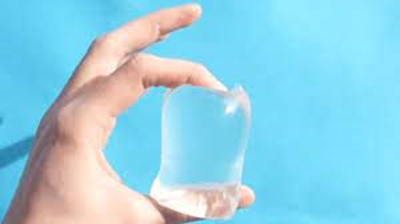Seaweed: The future of sustainable future
SEAWEED : The Future of Sustainable Packaging
You must have heard about edible water pouches!
These transparent water pouches can be directly eaten with its packaging material. The
packaging material is completely edible.
Lets take a look at speciality of these seaweed based
packaging.
From what is this packaging made?
This packaging is made from polysaccharides of marine macro algae
called seaweed. Seaweed are heterogeneous plants that live in either marine or
brackish water environments. It is one of several groups of multicellular algae: red, green and brown.
Brown Seaweed
14,073 Brown Seaweed Stock Photos and
Images - 123RF
How is the packaging developed?
Seaweeds are used globally to make biodegradable and edible
packaging materials. Polysaccharides such as agar, carrageenan and alginate are
extracted from seaweeds. These have excellent film forming properties. Then the
raw material is fermented without any chemical processing. The yeast residue
can then be converted into animal feed. The packaging is made edible without
the use of any adulterants or preservatives. However, seaweed films have high
water sensitivity, which indicates a poor water resistance due to the
hydrophilic nature of seaweeds extracts. Therefore, biopolymer films produced
from seaweed biomass are improved for desired characteristics to be used as a
packaging material.
Visakhapatnam centre of CIFT develops edible seaweed film that can replace plastic in food packaging - Frontline (thehindu.com)
Speciality in this packaging:
These bio-based polymer is non-toxic to nature. This
packaging degrades in just few days to few weeks in natural environment
depending upon plastic and environmental conditions.
Normally, microbes
use enzymes to slowly ‘eat’ biodegradable plastic. In the case of this new
material, however, the enzymes are built into the plastic itself. When the
plastic is thrown away, and the humidity and temperature are right, the enzymes
are activated. The enzymes break down the plastic more completely than
microbe-produced enzymes. This is because they go from one polymer chain to the
next, rather than breaking down the polymer in random areas. As a result, no
microplastic remains following decomposition. This could help overcome the
current environmental challenges associated with materials like oxo-degradable
plastics, which have been shown to decompose but to leave microplastic
fragments as they do, polluting soils and water.
Because the new
material will break down into monomers, it could also be recycled rather than
composted. And the embedded enzymes also break down the plastic more completely
than microbe-produced enzymes. Considering the edible bioplastics the
polysaccharides gets digested by bacteria present in human body.
Why Seaweed ?
Seaweed shows a promising future in the packaging industry
for several reasons:
·
Seaweed proliferates: As a raw
material, seaweed proves simple to cultivate, growing up to 3 meters a day. The entire crop is ready to harvest within a
little over a month, making the grow-time entirely manageable.
·
Seaweed is easily accessible: It
grows on every coastline. It’s also simple to extract from the shore or harvest
a crop.
·
Seaweed is inexpensive: Unlike other
crops, it doesn’t require fertilizers or freshwater, making it comparatively
cheap to produce.
·
Seaweed products decompose: Unlike
their plastic packaging counterparts, seaweed is biodegradable. Single-use
straws, or containers for restaurants, are biodegradable in four to six weeks. Some plastic bottles take
hundreds of years to decompose. Rather than let seaweed products disintegrate,
you can also choose to eat them.
·
Seaweed is sustainable: Scientists
collect the material to ferment it and create packaging. This process requires no chemical distillation, unlike similar materials. The procedure’s
only effect is a yeast by-product that can be converted and fed to farm
animals.
·
Seaweeds are nutritious: Seaweeds are
rich in minerals, antioxidants and fibers. They are also rich in protein
and vitamins.
The Tuck 360 Blog | Is Seaweed the Future of Sustainable Packaging? (dartmouth.edu)
The NOW and FUTURE of seaweed based packaging:
Currently, large-scale seaweed aquaculture only occurs in
Asian countries such as China, Japan, Indonesia and Korea, due to the
continent’s high demand for seaweed food products.
Indonesia is one of the largest seaweed producers in the world,
and the leading global producer of red seaweed. Evoware, a sustainable packaging company in Jakarta has been
creating food and other product packaging derived from seaweed since 2016,
demonstrating the materials’ efficacy as a packaging alternative that is not
only biodegradable but also edible.
plastic waste.
These “ohoo”
bubbles are created by company Notpla.
London Marathon Runners Were Handed
Seaweed Pouches Instead Of Plastic Bottles (forbes.com)
With more and more companies pledging to ‘go green’ and look
for innovative ways to package their products, seaweed packaging could grow to
become a worldwide source for small-scale packaging solutions looking at its
all over benefits. In terms of the large-scale products, seaweed may not work
due to costs, labour concerns and durability as of now.
oceans are
proving an abundant source for packaging alternatives – and companies are
turning to ocean-based plant fibres to create biodegradable containers and
wrappers.
The seaweed packaging as a replacement for plastic packages
is going to impact the cleanliness of the sea because no more plastic waste
will end up in the ocean and it will protect life below water since no more
fish, plankton or any marine living creatures will eat the micro plastic. Also,
it will significantly reduce the garbage in landfills and will improve air
quality.
Seeing these benefits countries are carrying out active
researches on improving the production techniques. In a densely populated
country like India, different hazardous plastics are used rampantly due to the
need for packaging of different consumer and food products. Researchers from
NIOT (National institute of ocean technology) have now however successfully
developed and tested bioplastic films by opting environment-friendly
techniques.
Seeing the trends, the seaweed industry is expected to
increase significantly around the globe in coming 10 years.
References:
2.
Development of Seaweed Biodegradable
Nanocomposite Films Reinforced with Cellulose Nanocrystals for Food Packaging;
Hansol Doh; Clemson University, hsdoh02@gmail.com
3.
Seaweed:
the new material of our sustainable future? (greenstories.co.in)
4.
3116290121Seaweed-PPT_28012021.pdf
(ncdc.in)
5.
Development
of biodegradable plastic from Marine Seaweed (vigyanprasar.gov.in)








Comments
Post a Comment